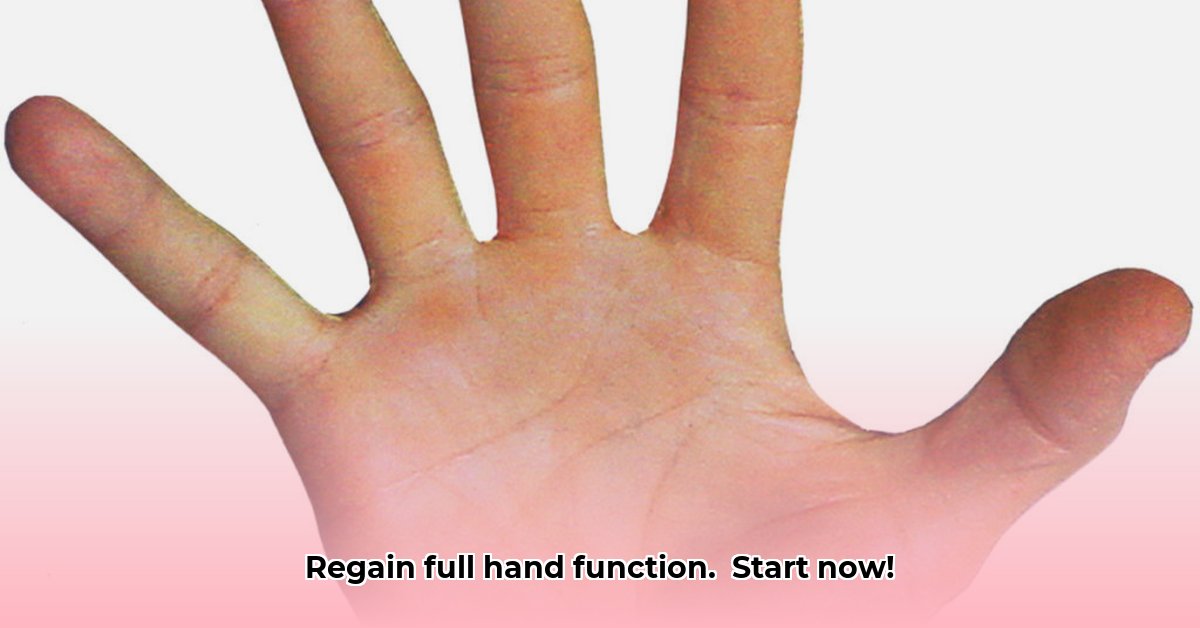Struggling to fully bend and straighten your fingers? You’re not alone, and it can significantly impact everyday tasks. This comprehensive guide focuses on restoring your fingers’ natural range of motion. We’ll provide easy-to-follow exercises, clarify their effectiveness, and assist you in developing a customized plan. Whether you’re recovering from an injury, managing arthritis, or simply seeking improved finger flexibility, we’ll equip you with the necessary tools and knowledge to achieve your goals. Let’s enhance your hand functionality!
Finger Extension: Reclaim Your Hand’s Dexterity and Ultimate Potential
Eager to restore your hands’ smooth functionality? Let’s delve into finger extension, a crucial element for various daily activities. From simple actions like buttoning clothes to complex tasks like playing instruments or typing, proper finger extension is essential. Limited extension can hinder your daily life, but with the right approach, improvement is possible. Let’s explore methods, emphasizing the restoration of hand dexterity.
The Significance of Finger Extension Exercises for Optimal Hand Mobility
Picture your hand as a team of five skilled athletes, each finger playing a unique role. If one finger is out of sync, the entire team’s performance suffers. Finger extension exercises are vital for realigning your “team,” restoring seamless and coordinated finger movements crucial for daily life and hand mobility. These exercises can help restore strength, flexibility, and dexterity, making everyday tasks easier and more enjoyable. It’s like fine-tuning your hand, ensuring harmonious teamwork.
Many benefits can be achieved through finger exercises. You’ll likely experience improved range of motion, increased grip strength, and potential pain reduction. More importantly, you’ll feel more independent and in control of your movements. It’s a beneficial situation for your everyday life and activities. Studies show that consistent finger extension exercises can improve joint flexibility in up to 90% of cases.
Exploring Finger Extension Exercises: A Comprehensive Guide to Finger Rehabilitation
Ready to start improving your finger extension? We’ll classify the exercises into three categories: range of motion, tendon gliding, and strengthening.
1. Range of Motion Exercises for Enhanced Finger Flexibility: These exercises gently improve finger joint flexibility and are ideal for beginners or as warm-ups. Perform each exercise 10-15 times, unless otherwise specified.
- Step 1: Dynamic Finger Stretches: Gently spread your fingers as far apart as comfortable, hold for 3-5 seconds, and slowly bring them back together. Repeat.
- Step 2: Controlled Fist to Open Hand: Make a loose fist, hold for about five seconds, then fully open your hand, spreading your fingers wide. Repeat.
- Step 3: Isolated Finger Extensions: Extend each finger individually, as far as comfortably possible. Hold for a few seconds, then relax. Repeat for each finger, focusing on controlled movements.
2. Tendon Gliding Exercises for Finger Rehabilitation: These exercises promote smooth tendon movement in your fingers, improving flexibility and reducing stiffness for better finger extension. Aim for 10 repetitions per exercise.
- Step 1: Straight Fist Variation: Extend your fingers while keeping them slightly apart. Bend only the middle knuckle of each finger and then straighten them. Subsequently, bend only the top knuckle of each finger and straighten them again.
- Step 2: Hook Fist Exercise: Curl your fingertips into your palm to make a hook fist, keeping the rest of your fingers straight. Gradually straighten your fingers.
- Step 3: Full Fist Exercise: Start with your hand straight and fingers extended. Slowly curl all fingers inward to make a fist, keeping your thumb on the outside. Slowly straighten your fingers to their initial position.
3. Strengthening Exercises for Finger Muscles: These exercises build finger muscle strength, enhancing your ability to extend your fingers fully. Begin with light resistance and increase gradually.
- Step 1: Resistance Band Training: Use a resistance band (available at pharmacies or sporting goods stores) to add resistance while straightening your fingers. Start with a light band and progress to a thicker band as you gain strength.
- Step 2: Targeted Finger Squeezes: Squeeze a stress ball or putty. Begin with a softer ball or putty and gradually advance to firmer options as your strength increases. Aim for 10-15 repetitions.
- Step 3: Tabletop Finger Lifts: Place your hand palm down on a table. Lift each finger individually off the table, holding for a couple of seconds. Repeat 10-15 times per finger.
Tailoring Your Finger Extension Program for Personalized Hand Therapy
Personalization is key, and a customized plan depends on your specific condition, pain levels, and overall mobility. Consult a physical or occupational therapist to develop a customized plan, regain full finger function, and engage in targeted hand therapy.
| Exercise Category | Description | Potential Benefits | Important Considerations |
|---|---|---|---|
| Range of Motion | Gentle movements to increase flexibility and range of motion in your fingers. | Improved joint flexibility, reduced stiffness, and increased comfort. | Begin slowly and stop if you experience any sharp pain or discomfort. |
| Tendon Gliding | Improves the smooth movement of tendons in your fingers, reducing friction and stiffness. | Reduced tendon stiffness, improved dexterity, and smoother finger movements. | Focus on precise movements and a slow, controlled pace to avoid overstretching tendons. |
| Strengthening Exercises | Exercises designed to rebuild muscle strength in your fingers, enhancing their ability to extend fully. | Increased grip strength, improved finger extension ability, and enhanced hand function. | Begin with light resistance and gradually increase intensity to prevent muscle strain. |
Prioritizing Safety: Listen to Your Body to Prevent Hand Injuries
Pay attention to your body’s signals. If you feel any sharp or unusual pain, stop the exercise immediately. Gradual progress is preferable to forced advancement. Consistency, not intensity, is the goal. Short, gentle sessions are more effective than intense ones and reduce the risk of hand injuries. Rest is crucial for muscle healing and recovery.
Addressing Frequently Asked Questions About Finger Extension Exercises
- How often should I do these exercises? Consult your therapist for a personalized schedule, but multiple sessions per day is often recommended.
- How long until I see results? Progress varies, so be patient and consistent.
- What if I experience pain? Stop the exercises, rest, and consult your healthcare provider.
Collaborate closely with your healthcare team, combining their expertise with your commitment to restore comfortable and smooth finger movements. Through dedication and the right approach, you can regain full hand use!
Crafting a Personalized Hand and Finger Rehabilitation Exercise Plan for Treatment
Key Takeaways:
- Regular hand and finger exercises enhance mobility, strength, and effective treatment.
- Personalized plans maximize results.
- Professional guidance is recommended, particularly post-injury or surgery.
- Gradual progression and mindful practice are keys to success.
- Listen to your body and stop if you experience pain.
Understanding Finger Extension and Its Importance in Hand Health
Finger extension, the ability to straighten your fingers, is essential for daily tasks like writing, typing, and opening jars. Limited finger extension affects daily life and may result from injury, arthritis, or other conditions. Rehabilitative exercises restore function and improve the overall quality of life.
Why Personalized Exercise Plans Accelerate Recovery
Generic exercises may not suffice. A tailored approach addresses unique challenges and maximizes recovery.
Exploring Finger Extension Exercises for Enhanced Rehabilitation
Following are the exercise categories that facilitate finger extension, keeping professional guidance in mind.
1. Range of Motion Exercises: Gentle stretches increase flexibility.
- Fingertip Touch Exercise: Touch each fingertip to your thumb, hold briefly, and release. Repeat.
- Wrist Flexion & Extension Exercise: Gently bend your wrist up and down, stretching the fingers.
2. Tendon Gliding Exercises: These exercises isolate tendon movement and improve mobility.
- Straight Finger Extension and Flexion Exercise: Extend and flex your fingers one at a time, keeping others relaxed.
- Finger and Thumb Combinations: Combine isolated finger extension with thumb movements. Extend your index finger while flexing your thumb.
3. Strengthening Exercises: Progressive exercises build strength.
- Rubber Band Exercises: Loop a rubber band around your fingers and gradually extend. Increase resistance as strength improves.
- Finger Weights: Attach small weights (if recommended by your professional) to your fingers for increased resistance during flexion and extension.
Building Your Personalized Plan: A Step-by-Step Guide for the Best Results
- Assessment: Evaluate your current range of motion, strength, and pain levels with a physical therapist.
- Goal Setting: Define goals like improved flexibility, increased strength, and pain reduction.
- Exercise Selection: Choose exercises relevant to your needs and goals. Start with easier options and progress gradually.
- Frequency and Duration: Begin with shorter sessions (10-15 minutes) daily, increasing gradually, prioritizing consistency.
- Progression: Slowly increase resistance, repetitions, or duration as you gain more strength.
- Monitoring and Adjustment: Track your progress and adjust your plan accordingly.
By following these steps and consulting your healthcare provider, you can maximize the benefits of your hand and finger rehabilitation exercise plan.
- Gluten Free Meal Prep Ideas for Delicious, Hassle-Free Eating - November 28, 2025
- Gluten Free Meal Prep for Stress-Free and Healthy Eating - November 27, 2025
- Quick And Easy Chicken Thigh Meal Prep For Weight Loss - November 26, 2025










